The seven wonders of the ancient world are examples of exceptional pieces of classical architecture and human achievement.
The first list of the seven wonders dates back to the first or second century BC when it acted as a kind of guidebook for Hellenic sightseers.
Compiled by ancient scholars, the list contains the most astounding centerpieces of great architecture and engineering and demonstrates the inventiveness, creative ability, and sheer diligence of the ancient world.
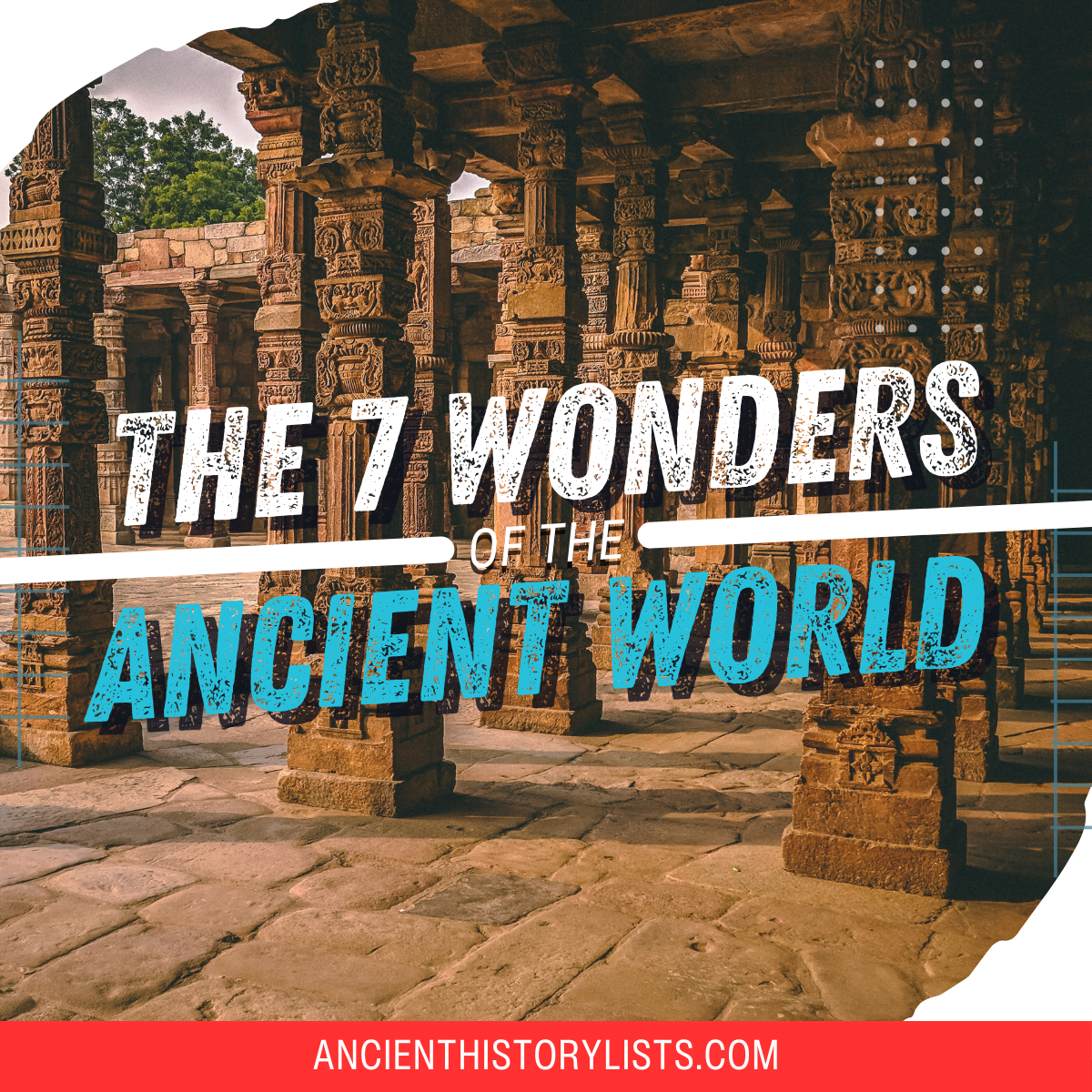
All but one of these ancient marvels have now been lost. The Great Pyramid of Giza stands alone as the last physical piece of evidence of the original seven; the Mausoleum at Halicarnassus, the Colossus of Rhodes, the Lighthouse of Alexandria, the Statue of Zeus, and the Temple of Artemis have all been destroyed.
The exact position and origins of the Hanging Gardens are obscure, and there is some debate about whether they even existed at all. The Seven Wonders of the Ancient World were:
- The Great Pyramid of Giza, Egypt
- The Statue of Zeus at Olympia, Greece
- The Hanging Gardens of Babylon, Iraq
- The Mausoleum at Halicarnassus, Turkey
- The Temple of Artemis at Ephesus, Greece
- The Colossus of Rhodes, Greece
- The Lighthouse at Alexandria, Egypt
7. The Great Pyramid of Giza, Egypt
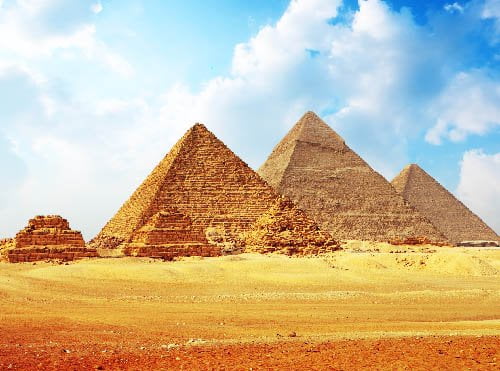
The only wonder of the ancient world that still exists, the Great Pyramid of Giza, was built around 2584 to 2561 BC for the Egyptian pharaoh Khufu (referred to in Greek as Cheops) and was the tallest manmade structure on the planet for just about 4,000 years.
It is situated in the north of the country near to Cairo and the Nile. The three pyramids of Khufu, Khafre, and Menkaure were built between approximately 2700 BC and 2500 BC and served as illustrious tombs for the pharaohs.
The biggest and most amazing pyramid, Khufu’s pyramid, covers around 13 acres of land and is believed to contain more than two million stone blocks weighing from 4,000 to 60,000 pounds (2 to 30 tons) each, and it took until the 19th century for anyone to build anything taller.
Incredibly, the pyramids were constructed without the use of modern technology or building instruments and it is thought that the Egyptians used sledges and rollers made of logs to move heavy stones and boulders.
The sloped walls, which were intended to represent the beams of light from the sun god, Ra, were initially worked as steps, and after that, limestone was used to fill them in.
The pyramids’ interiors have narrow halls and concealed chambers in an attempt to thwart graverobbers. Although present-day archaeologists have discovered great treasures among the remains of the pyramids, many of the valuables had already been looted.
Exploration of the inside of the pyramids only started in earnest in the late 18th and mid-19th centuries and early scholars had no knowledge of their complex interiors. It was simply the external structure with its perfect symmetry and amazing height which inspired ancient travelers.
6. The Statue of Zeus at Olympia, Greece
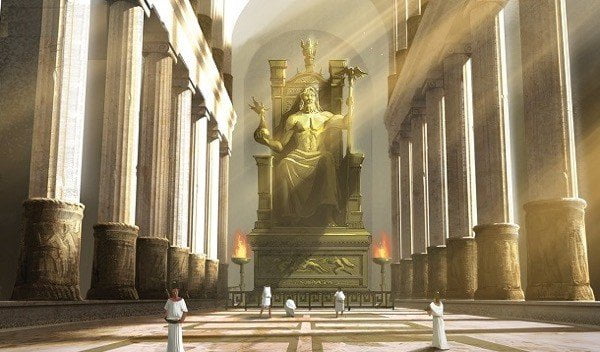
The internationally celebrated Statue of Zeus was made by the Athenian sculptor Phidias and placed in the Sanctuary of Zeus at Olympia, the site of the ancient Olympics, around the middle of the fifth century BC.
Phidias was the greatest artist of the ancient world in the fifth century BC who also worked on the Parthenon and the statue of Athena which can be found there.
The Statue of Zeus shows the god in a position of authority, his skin made of ivory and his robes of hammered gold. It stands 12 meters tall and was intended to inspire wonder and awe in those who visited the temple.
The statue showcased the divine force of thunder seated with a bare chest in a position of authority. Two carved sphinxes, which are legendary animals with the chests and heads of women, birds’ wings, and lions’ bodies, act as the god’s armrests.
The historian Strabo reports that despite the vastness of the sanctuary itself, the sculptor had not taken the roof height into account when positioning the statue. Zeus is in a seated position with his head practically touching the roof, so we have the feeling that if he were to stand up he would take the roof off the sanctuary.
The Statue of Zeus graced the sanctuary at Olympia for over eight centuries but under the direction of Christian advisors, the Roman ruler Constantine the Great was encouraged to shut down the sanctuary in the fourth century AD. Around that time, the statue was moved to Constantinople and it is believed to have been destroyed by fire in the year 462.
5. The Hanging Gardens of Babylon, Iraq
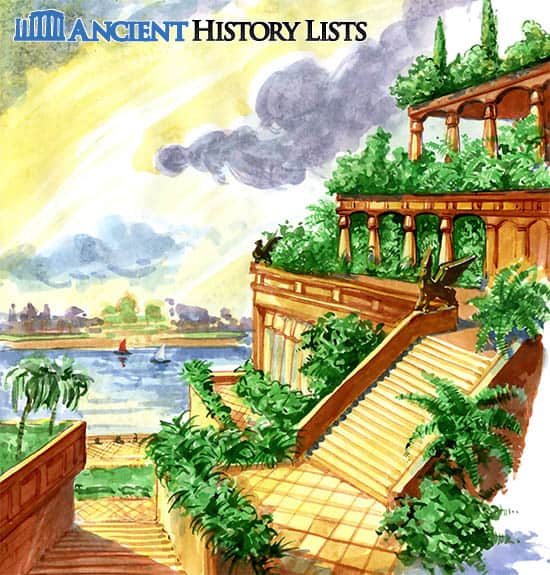
From ancient Greek texts, it is thought that the Hanging Gardens of Babylon were close to the Euphrates in modern-day Iraq and were built by the Babylonian ruler Nebuchadnezzar II between 605 and 562 BC for his wife, Amytis of Media.
They are described by the ancient writer Diodorus Siculus as self-watering planes of colorful greenery achieving a height of more than 23 meters through a progression of climbing terraces.
Diodorus reports that Nebuchadnezzar’s wife missed the mountains and forests of her homeland and so the ruler declared that a mountain should be made for her in Babylon.
The controversy over whether the gardens actually existed originates from the fact that they are not mentioned at all in Babylonian history and the “Father of History” Herodotus doesn’t mention them in any of his descriptions of Babylon either. However, Herodotus also omits numerous other well-known facts, figures, and places in history.
Diodorus, Philo, and Strabo all claim that the gardens existed but were destroyed by an earthquake at some point after the first century AD. Later writers describe how visitors could stroll beneath the wonderful stone terraces, but it is generally accepted that the gardens were a popular myth.
4. The Mausoleum at Halicarnassus, Turkey
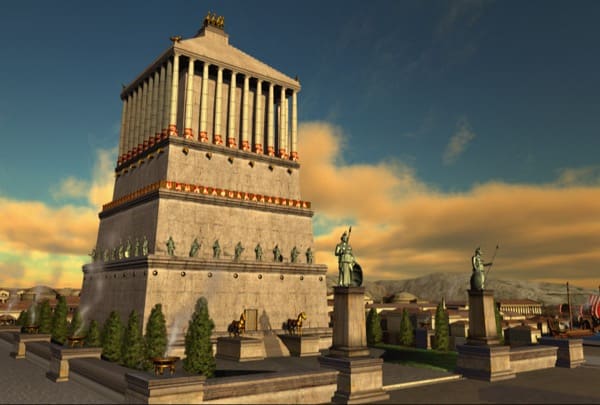
Situated in the southeastern part of present-day Turkey, the Mausoleum at Halicarnassus was a tomb which Artemisia had built for her husband, Mausolus, the ruler of Carnia, after his death in 353 BC.
The aim was to create a structure whose magnificence would be unmatched on the planet. The gigantic catacomb was made completely of white marble and is thought to be 135 feet (41 meters) tall. The building’s complex plan, comprising of three layers in a rectangular shape, is believed to have incorporated Lycian, Egyptian, and Greek design styles.
The principal layer was comprised of steps with a 60-foot base, followed by a central layer made of 36 sections and a pyramid-shaped roof. At the peak of the roof was the tomb, crafted by four stonemasons, and a marble chariot with four horses each measuring 20 feet.
It was destroyed by a series of earthquakes and lay in ruins for many years until, in 1494 AD, the site was cleared and used by the knights of St John of Malta as their stronghold at Bodrum (where the old stones can still be seen today).
It is from the tomb of Mauslos that the English word “mausoleum” comes. In 1846, pieces of one of the tomb’s friezes were excavated and are now housed in London’s British Museum along with other relics from Halicarnassus.
3. The Temple of Artemis at Ephesus, Greece
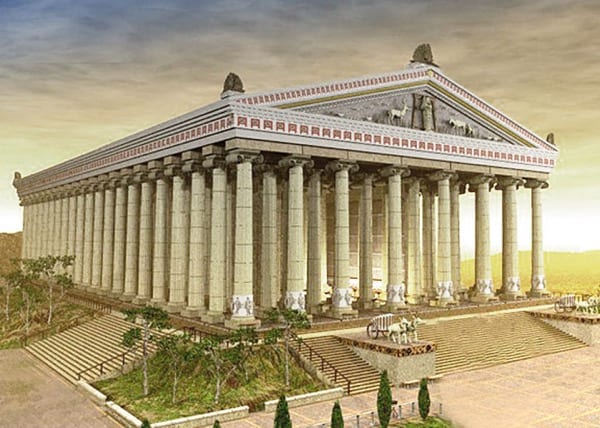
The building of the Temple of Artemis at Ephesus was funded by the affluent King Croesus of Lydia, who spared no expense in anything he did (as indicated by the historian Herodotus, among others).
The magnificence of the sanctuary has been praised by various ancient sources which all agree that it was the most astounding structure ever built.
It took over 120 years to build the temple but only a single night to demolish it. Completed in 550 BC, the temple was around 129 meters high, 69 meters wide, and supported by 127 eighteen-meter high columns.
In fact, there was more than one Temple of Artemis. A series of sacred places and sanctuaries were demolished and rebuilt on the same site in Ephesus, a Greek port city on the western coast of modern-day Turkey. The most spectacular of these structures were two marble sanctuaries built around 550 BC and 350 BC respectively.
The first was designed by the Cretan architect Chersiphron and his son Metagenes and constructed by probably the most acclaimed craftsmen of the ancient world. On July 21, 356 BC a man named Herostratus set fire to the sanctuary in order to gain notoriety for destroying something so magnificent.
The Ephesians declared that his name should neither be recorded nor recalled, however Strabo mentioned him when describing the structure’s history. It is said that Alexander the Great was conceived on the night that the temple burned and he later offered to reconstruct it, an offer that was declined by the Ephesians.
It was rebuilt on a more modest scale after Alexander’s death, but was destroyed again by the invasion of the Goths. After being rebuilt yet again, it was finally destroyed for good by Christians led by Saint John Chrysostom in 401 AD.
2. The Colossus of Rhodes, Greece
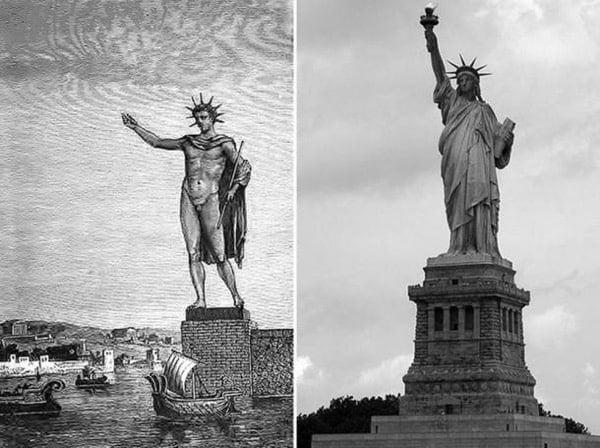
The Colossus of Rhodes was a gigantic bronze model of the sun god Helios (the great god of the island of Rhodes) built between 292 and 280 BC.
It stood a little over 33 meters high and overlooked the harbor of Rhodes. Despite popular stories to the contrary, it stood with its legs together on a base to support its weight (much like the Statue of Liberty which is based on the Colossus) and did not straddle the harbor.
The statue was commissioned to celebrate Rhodes’ victory over the attacking forces of Demetrius in 304 BC. Demetrius left behind much of his siege equipment during his retreat and the money raised from the sale of this weaponry (around 360 million US dollars in today’s money) was used to build the Colossus.
The people of Rhodes spent more than 12 years in the third century BC constructing the Colossus. Designed by the sculptor Chares, it stood 100 feet (30 meters) tall, making it the highest statue in the ancient world. It was finished sometime in 280 BC and stood for just 56 years before it was destroyed by an earthquake in 226 BC.
It lay in ruins for more than 800 years, according to the historian Strabo. When the Arabs attacked Rhodes many years later, they sold the remaining parts of the magnificent statue as scrap metal. Because of this, very little is known about the statue’s exact location or appearance.
Most people believe that Helios is depicted as standing nude and raising a light with one hand and holding a lance in the other.
1. The Lighthouse at Alexandria, Egypt
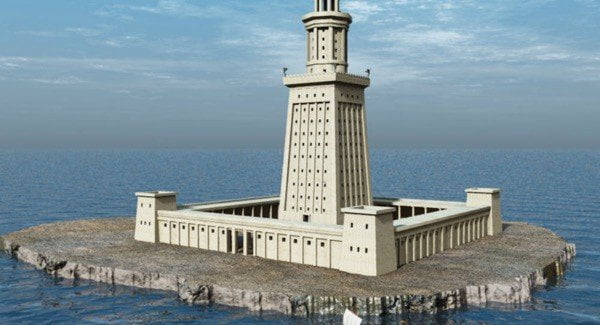
The Lighthouse at Alexandria was situated on the small island of Pharos close to the city. It was built by the Greek engineer Sostratus and completed around 280 BC.
During the reign of Ptolemy II, it was used to guide ships down the Nile. It was seriously damaged in an earthquake in 956 and again in 1303 and 1323. By the year 1480, it was no more, although pieces of the original have been found at the bottom of the Nile.
The lighthouse rose from a square base to a central octagonal section with a cylindrical structure at the top and its light could be seen 35 miles out to sea. It is thought that the only contemporary structures taller than the lighthouse were the pyramids. Those who saw the lighthouse said that there were no words to describe its magnificence.
The Egyptian Citadel of Qaitbay now sits on the site and has been partly built out of stones from the original structure. The lighthouse was estimated to have been anywhere between 200 and 600 feet (60 to 180 meters) tall but recent research suggests it was probably closer to 380 feet (116 meters).
What about the temple of Solomon?
Amos is right.!
What about the temple of Solomon?
#4 is The Tomb of Mausolus at Halicarnassus, Turkey. The term “mausoleum” didn’t come about until around 1800 years after the tomb was built, and was named for King Mausolus and his tomb.